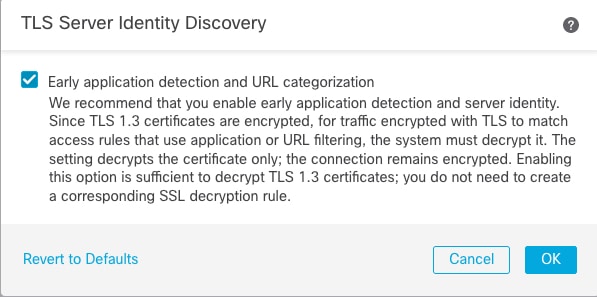Access Control Policy Components
Following are the main elements of an access control policy.
- Name and Description
-
Each access control policy must have a unique name. A description is optional.
- Inheritance Settings
-
Policy inheritance allows you to create a hierarchy of access control policies. A parent (or base) policy defines and enforces default settings for its descendants, which is especially useful in multidomain deployments.
A policy's inheritance settings allow you to select its base policy. You can also lock settings in the current policy to force any descendants to inherit them. Descendant policies can override unlocked settings.
- Policy Assignment
-
Each access control policy identifies the devices that use it. Each device can be targeted by only one access control policy. In a multidomain deployment, you can require that all the devices in a domain use the same base policy.
- Rules
-
Access control rules provide a granular method of handling network traffic. Rules in an access control policy are numbered, starting at 1, including rules inherited from ancestor policies. The system matches traffic to access control rules in top-down order by ascending rule number.
Usually, the system handles network traffic according to the first access control rule where all the rule’s conditions match the traffic. Conditions can be simple or complex, and their use often depends on certain licenses.
- Default Action
-
The default action determines how the system handles and logs traffic that is not handled by any other access control configuration. The default action can block or trust all traffic without further inspection, or inspect traffic for intrusions and discovery data.
Although an access control policy can inherit its default action from an ancestor policy, you cannot enforce this inheritance.
- Security Intelligence
-
Security Intelligence is a first line of defense against malicious internet content. This feature allows you to block connections based on the latest IP address, URL, and domain name reputation intelligence. To ensure continual access to vital resources, you can override Block list entries with custom Do Not Block list entries.
- HTTP Responses
-
When the system blocks a user’s website request, you can either display a generic system-provided response page, or a custom page. You can also display a page that warns users, but also allows them to continue to the originally requested site.
- Logging
-
Settings for access control policy logging allow you to configure default syslog destinations for the current access control policy. The settings are applicable to the access control policy and all the included SSL, prefilter, and intrusion policies unless the syslog destination settings are explicitly overridden with custom settings in included rules and policies.
- Advanced Access Control Options
-
Advanced access control policy settings typically require little or no modification. Often, the default settings are appropriate. Advanced settings you can modify include traffic preprocessing, SSL inspection, identity, and various performance options.
 )
) )
) )
) )
)
 )
) )
) )
)
 )
)

 )
) )
) )
) Feedback
Feedback